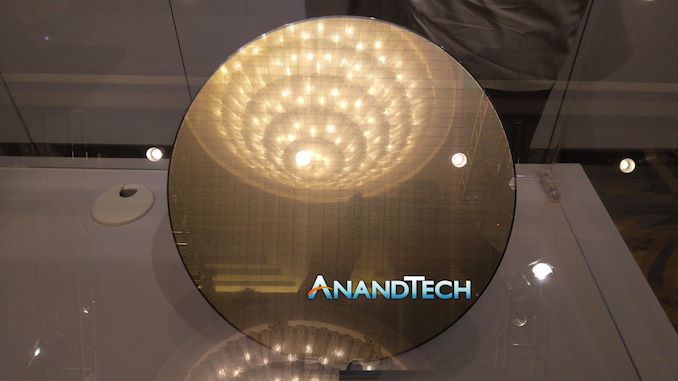Spotted: Qualcomm Snapdragon 8cx Wafer on 7nm
by Ian Cutress on December 6, 2018 4:35 PM EST
Alongside the announcement of the new 7nm Qualcomm Snapdragon 8cx processor for the company’s line of next generation premium tier Always Connected PCs, in the demo room today we saw a wafer of chips built on TSMC’s 7nm.
With this image, we can do one primary thing: work out the die size. Based on our estimates, we can see about 36 chips from top to bottom, and 22.2 chips from side to side. On a standard 300mm wafer, and give a little for the small amount of unused silicon from die to die so they can be cut up, we get a reasonable die size value of 112 square millimeters. This is what we expect to be the upper bound, and the final result may be lower.
That 112 mm2 is from a height of 8.3 mm and a width of 13.5 mm (which technically makes 112.05 mm2, but there is always margin for error here). This would make a total of 532 dies per wafer. There is no mention of defect rate or price per wafer in order to do an analysis of cost per die in manufacturing terms, but if ever get that information it would be an interesting metric.
In the slides, Qualcomm stated that the 8cx has double the transistors. We assume that’s a comparison to the Snapdragon 850, which is an overclocked S845, which had 5.3 billion transistors on the 10nm node. This would make the 8cx at around ~10 billion transistors (to 10.6b) at 112 mm2, or the equivalent of 89-95 million transistors per square millimeter (MTr/mm2). The Snapdragon 845/850 on 10nm would have been 56 MTr/mm2.
*It has come to our attention that the slide listing '2x transistors' was only referencing the size of the graphics of the chip, and not the whole chip itself. The table has been updated.
| Die Size and Transistor Counts | |||||
| AnandTech | Process Node | Die Size (mm) |
Die Area (mm2) |
Tr | Density (MTr/mm2) |
| Snapdragon 8cx | 7nm TSMC | 8.3 x 13.5 | 112* | > 5.3b < 10.6b |
> 56.4 < 94.6 |
| Snapdragon 845/850 | 10LPP Samsung | 94 | 5.3 b | 56.4 | |
| Snapdragon 835 | 10LPE Samsung | 72.3 | 3.0 b | 41.5 | |
| Kirin 980 | 7nm TSMC | 74.13 | 6.9 b | 93.1 | |
| Kirin 970 | 10nm TSMC | 9.75 x 9.92 | 96.72 | 5.5 b | 56.9 |
| Kirin 960 | 16nm TSMC | 10.77 x 10.93 | 117.72 | 4.0 b | 34.0 |
| Apple A12 Bionic | 7nm TSMC | 9.89 x 8.42 | 83.27 | 6.9 b | 82.9 |
| Exynos 9810 | 10LPP Samsung | 10.37 x 11.47 | 118.94 | ? | ? |
| 8-core Ryzen | 14nm GloFo | 22.06 x 9.66 | 192 | 4.8 b | 25.0 |
| Skylake 4+2 | 14nm Intel | 13.31 x 9.19 | 122 | 1.75 b | 14.3 |
| *Upper Bound | |||||
More information as we get it.










15 Comments
View All Comments
harshw - Thursday, December 6, 2018 - link
Shouldn’t the 8cx be compared to the A12X as the use case for the 8cx is for PCs and laptops? Do we have details for the die size for the A12X?Death666Angel - Thursday, December 6, 2018 - link
Will an A12X ever find its way into a non-Apple / MacOS / iOS based system?Will an 8ca ever find its way into an Apple / MacOS / iOS based system?
I would be willing to bet a lot of money that no is the answer to both, so I don't see the reason to compare them to be very good.
defferoo - Thursday, December 6, 2018 - link
two ARM SoCs in similar power envelopes, both on the same 7nm TSMC process shouldn't be compared? just because they're not directly competing against each other doesn't mean it wouldn't be interesting to compare them. they are indirectly competing of course, an ACPC is definitely competing against the cellular iPad. after hearing about this, first thing that popped into my mind was how it compares to A12X.levizx - Friday, December 21, 2018 - link
Yet A12 was listed, even further away from possibility.name99 - Friday, December 7, 2018 - link
Ideally yes. But no public die shots of the A12X yet exist...Death666Angel - Thursday, December 6, 2018 - link
One suggestion, mTr would make more sense as MTr. Million = 10^6 = Mega = M.m = milli = 10^-3.
Otherwise, thanks a lot for the work. :D
levizx - Friday, December 21, 2018 - link
Again, nonsense. It is 5.3 Billion Transistors in 94mm^2, so, 5300/94 Million Transistors/mm^2how would miliTr make any sense?
platinumjsi - Friday, December 7, 2018 - link
How come Skylakes density is so low?I know TSMC 7nm is denser than Intel's 14nm but I didn't realize it was 6 - 7x denser?
shing3232 - Friday, December 7, 2018 - link
Skylake is very high frequency design compare everything in the market that's why.name99 - Friday, December 7, 2018 - link
This just shows the bizarre incoherence of everything about Intel these days.What they make their serious money on it high-frequency designs, not dense designs. But in spite of that, their advertising is (was?) obsessed with boasting about density --- density that is irrelevant to most of what they sell.
Even worse, they seem to have destroyed 10nm in an ever more obsessive push for that density! The 10nm disaster would make sense if they couched it in terms like "our goal was transistors + metal that allowed for 35% higher frequency", but that was not the public discussion, and it's not clear that it was the internal discussion.